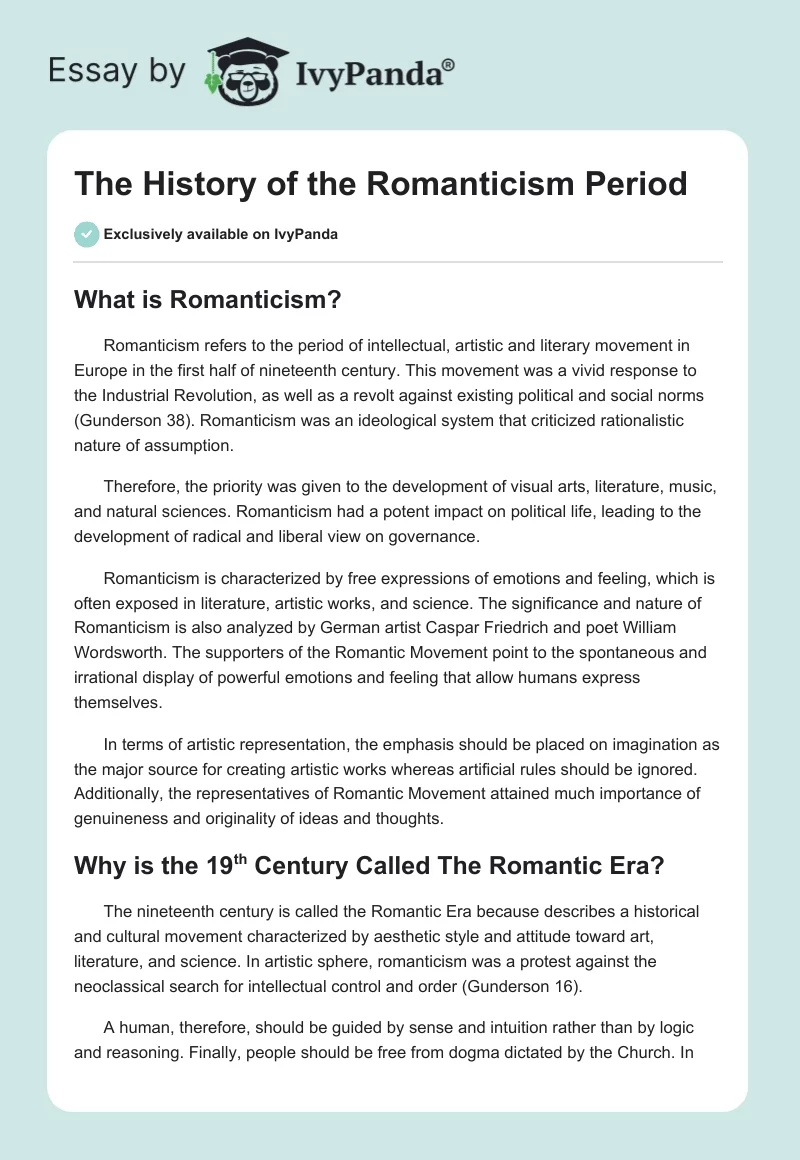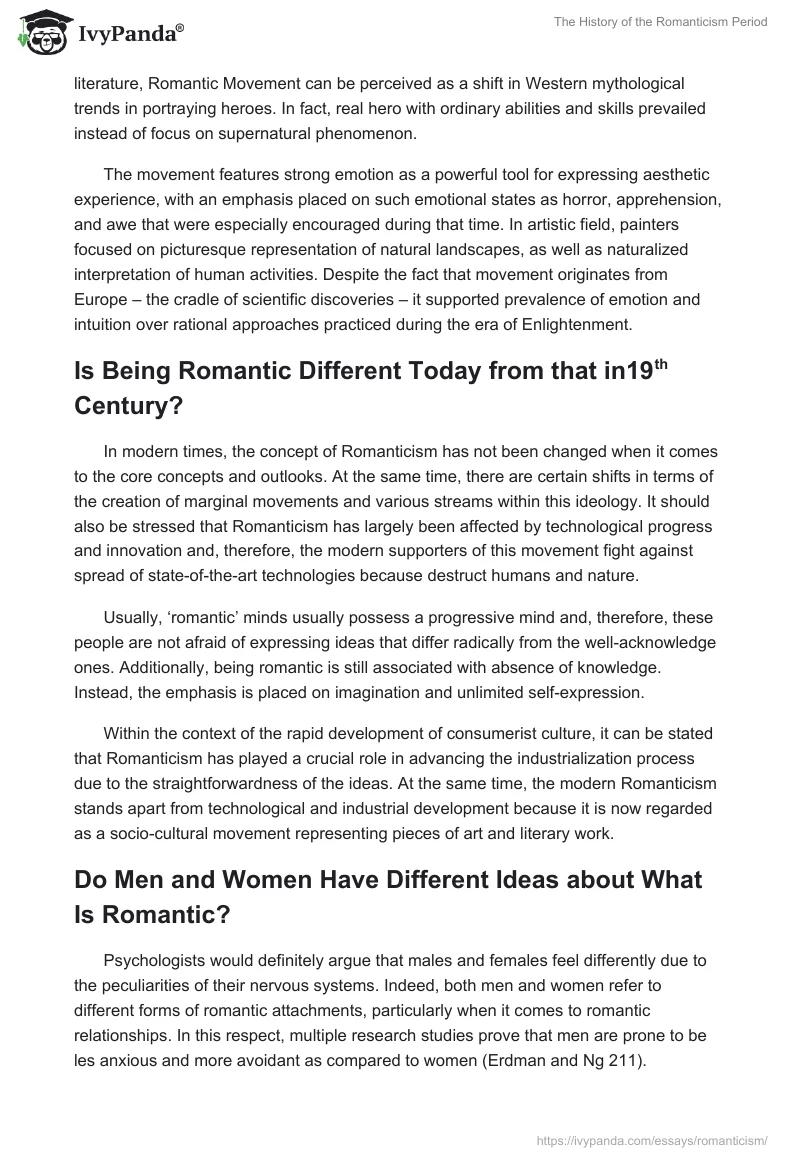What Is Romanticism?
Romanticism refers to the period of intellectual, artistic and literary movement in Europe in the first half of nineteenth century. This movement was a vivid response to the Industrial Revolution, as well as a revolt against existing political and social norms (Gunderson 38). Romanticism was an ideological system that criticized rationalistic nature of assumption.
Therefore, the priority was given to the development of visual arts, literature, music, and natural sciences. Romanticism had a potent impact on political life, leading to the development of radical and liberal view on governance.
Romanticism is characterized by free expressions of emotions and feeling, which is often exposed in literature, artistic works, and science. The significance and nature of Romanticism is also analyzed by German artist Caspar Friedrich and poet William Wordsworth. The supporters of the Romantic Movement point to the spontaneous and irrational display of powerful emotions and feeling that allow humans express themselves.
In terms of artistic representation, the emphasis should be placed on imagination as the major source for creating artistic works whereas artificial rules should be ignored. Additionally, the representatives of Romantic Movement attained much importance of genuineness and originality of ideas and thoughts.
Why Is the 19th Century Called the Romantic Era?
The nineteenth century is called the Romantic Era because describes a historical and cultural movement characterized by aesthetic style and attitude toward art, literature, and science. In artistic sphere, romanticism was a protest against the neoclassical search for intellectual control and order (Gunderson 16).
A human, therefore, should be guided by sense and intuition rather than by logic and reasoning. Finally, people should be free from dogma dictated by the Church. In literature, Romantic Movement can be perceived as a shift in Western mythological trends in portraying heroes. In fact, real hero with ordinary abilities and skills prevailed instead of focus on supernatural phenomenon.
The movement features strong emotion as a powerful tool for expressing aesthetic experience, with an emphasis placed on such emotional states as horror, apprehension, and awe that were especially encouraged during that time. In artistic field, painters focused on picturesque representation of natural landscapes, as well as naturalized interpretation of human activities. Despite the fact that movement originates from Europe – the cradle of scientific discoveries – it supported prevalence of emotion and intuition over rational approaches practiced during the era of Enlightenment.
Is Being Romantic Different Today from That in the 19th Century?
In modern times, the concept of Romanticism has not been changed when it comes to the core concepts and outlooks. At the same time, there are certain shifts in terms of the creation of marginal movements and various streams within this ideology. It should also be stressed that Romanticism has largely been affected by technological progress and innovation and, therefore, the modern supporters of this movement fight against spread of state-of-the-art technologies because destruct humans and nature.
Usually, ‘romantic’ minds usually possess a progressive mind and, therefore, these people are not afraid of expressing ideas that differ radically from the well-acknowledge ones. Additionally, being romantic is still associated with absence of knowledge. Instead, the emphasis is placed on imagination and unlimited self-expression.
Within the context of the rapid development of consumerist culture, it can be stated that Romanticism has played a crucial role in advancing the industrialization process due to the straightforwardness of the ideas. At the same time, the modern Romanticism stands apart from technological and industrial development because it is now regarded as a socio-cultural movement representing pieces of art and literary work.
Do Men and Women Have Different Ideas About What Is Romantic?
Psychologists would definitely argue that males and females feel differently due to the peculiarities of their nervous systems. Indeed, both men and women refer to different forms of romantic attachments, particularly when it comes to romantic relationships. In this respect, multiple research studies prove that men are prone to be les anxious and more avoidant as compared to women (Erdman and Ng 211).
When men become attached to relationships, they tend to create distance to be on the save side and make things easier. In fact, they ignore romantic attachments and feelings. In contrast, women tend to be more anxious. Being attached increases their anxiety and therefore, close relationships could be more disruptive for women in emotional terms, as compared to men. In this respect, it can be concluded that women are more prone to be romantic because they are not afraid of expressing their feelings whereas men are expected to use reason to take control of the situation.
Is Romanticism Universal or Do Different Cultures Have Different Ideas?
When it comes to the different views on romanticism in various cultures, the focus should be on the concept of collectivism and individualism, as well as on low-context and high-context cultures. In this respect, Western countries, in which the priority is given to individualism and low-context dependence, romanticism is closely associated with freedom of self-determination and expression of ideas (Erdman and Ng 215).
In Eastern countries, which are characterized by individualism and high-context environment, people are less oriented toward romanticism because individuals are highly affected by traditions, rituals, and customs that restrict human freedom to express their emotions freely.
Work Cited
Erdman, Phyllis, and Kok-Mun Ng. Attachment: Expanding the Cultural Connections. US: Taylor & Francis. 2010. Print.
Gunderson, Jessica. Romanticism. US: The Creative Company, 2008. Print.


